
Coming to Scotland? Attending a Clan or Family Gathering? Want to get it right?
Well aware that feathers may be ruffled and noses out-jointed, Dr Bruce Durie, Shenachie to the Chief of Durie, offers this straightforward guide…

Coming to Scotland? Attending a Clan or Family Gathering? Want to get it right?
Well aware that feathers may be ruffled and noses out-jointed, Dr Bruce Durie, Shenachie to the Chief of Durie, offers this straightforward guide…
Highland games, gatherings, processions and so on are marvellous opportunities to show allegiance to a Clan, Family or Name, a feeling for heritage and support for all things Scottish. However, when In Scotland, all things heraldic and armorial are a matter of law – not just custom and practice – so it make sense to know what the rules are and how to obey them.
1. If you don’t have a Coat of Arms, don’t display a Coat of Arms
Few things cause more confusion and heated argument than Arms.
FACT: A Crest is not the same as Arms. The Crest is one component of Arms – it is the device originally worn on top of the helmet, and nowadays depicted above the escutcheon (the shield) or alone as a Crest Badge (see below). The Arms are usually shown either as just the shield or as the full “achievement” of shield, helmet-wreath-mantling, crest, motto and (if any) supporters.
FACT: There is NO SUCH THING as a “Family Coat of Arms” in Scotland – Arms are the personal, heritable property of one person and just because you share a surname does NOT mean you can use these Arms, any more than you could drive away in that person’s car. MAKE NO MISTAKE – these matters are regulated by Statute Law in Scotland and there are real penalties, including fines, confiscation and ultimately jail, for “pretending to Arms” that are not yours.
FACT: A Clan or Family may have a number of Armigers (people legally entitled to bear Arms) but the “undifferenced” Arms will typically be borne by the Chief of that Name.
BOTTOM LINE: Unless you personally have been granted Arms by Lord Lyon,
do not display Arms. If an ancestor of yours had Arms, by all means apply to
have these re-matriculated in your name
(consult www.lyon-court.com)
YOU CAN WEAR OR DISPLAY THE CREST
Any kinsman/kinswoman of an armigerous Chief of Name and Arms may wear a device bearing the Chief’s Crest. Typically this will be a strap-and-buckle design, worn as a cap-badge, kilt-pin, plaid brooch etc. and used as a graphic image (on literature, merchandise and the like). In theory, the Crest belongs to the Chief (or senior Armiger) and properly, permission should be sought and fealty sworn. But informally, most Chiefs are only too happy to see as many people as possible wearing the Crest Badge.
The Chief, by the way, wears the Crest inside a simple circlet, with three eagle feathers. Chieftains and the heir of the Chief wear two feathers. Armigers of that name wear a single feather.
2. Clan or Family?
This is the other great bone of contention. Not every name in Scotland is attached to a Clan. The Clan is a Highland phenomenon – but by extension the term Clan is applied to those Borders families who were organised and behaved as Clans. Names from the Lowlands are considered to be in Families. Bruce is not a Clan. Douglas is not a Clan. Wallace is not a Clan. Wood is not a Clan.
The “Lowlands”, by the way, includes some areas quite far north in Scotland – the non-mountainous areas of Angus, Aberdeenshire, Nairnshire and so on. Roughly, draw a line north-east from Dumbarton to Aboyne, then north to about Aberlour, and north-west to Nairn – anything to the left of that is Highlands.
There is a list of Clans, as defined at the point where many of their
jurisdictional powers were taken away, taken from the Acts of Parliament 1587 &
1594. There’s a corresponding map with Possessions of the Highland Proprietors
at:
http://commons.wikimedia.org/wiki/File:Map_of_the_clans_of_Scotland_(1899,_third_edition).jpg
A Clan or Family which has a recognised Chief or other head has “noble” status, legally recognised and with a corporate identity. A Family or Name group with no recognised chief has no official position in Scots law. Douglas, for instance, having no Chief, can never be a Clan – it is subsumed under Hamilton (Chief, His Grace Alexander, 16th Duke Of Hamilton) and the last Chief of Clan Douglas (Archibald, 1st Duke of Douglas) died in 1761.
In any case, the ancient clan system more or less went away after the Clans Act and other laws of the immediate post-1745 period, and the remnant of it we know today was re-created in the first quarter of the 19th century, largely by the enthusiasm of Sir Walter Scott and the visit to Edinburgh he organised for King George IV in 1822.
LORD LYON DOES NOT REGULATE CLANS
When Lord Lyon grants Arms to a Chief, the Letters Patent may say something like: “Angus McSneckie of McSneckie, Chief of the Name and Arms of Clan McSneckie” but this merely acknowledges that the Clan exists, not that Lord Lyon has conferred “Clan” status. Lyon exercises no jurisdiction over what is or is not considered a “Clan”, but can offer advice on how a Clan or Family can go about appointing or recognising a Chief after a Family Convention or Derbhfine. There are roughly 140 Clans and Names that have Chiefs recognised by the Lord Lyon.
Recognised Chiefs can belong to the Standing Council of Scottish Chiefs of Clans and Names (SCSC – www.clanchiefs.org) but be aware that this body does not regulate Clans and Families, nor is it an umbrella body for Clan and Family Societies.
Mc or Mac?
Mc is Irish and Mac is Scottish. Or is it the other way round? Actually, it’s neither – McNaewhere (and for that matter M’Naewhere) are just abbreviations for MacNaewhere. The Mc or Mac form may have become fixed over time in one particular branch, but it does not signify origin. Also, don’t fret over variants – a McKay is a MacKay is a M’Kay is a McCay is a Mackey is a Makee is a Makey, and all are derived from MacHugh (Gaelic, MacAoidh).
3. Banners, Pennants and Standards – get it right
Planning to fly a flag or carry a “banner” of some sort at a Gathering in
Scotland? Lovely idea, but do get it right. Almost all forms of flag are
personal to the Armiger, just like Arms.

Lion Rampant (left) and Saltire (right)
DO NOT FLY THE LION RAMPANT – FLY THE SALTIRE
First of all, the Lion Rampant is part of the Arms of the Sovereign and the Great Officers of State of Scotland. It is the personal Banner of the King or Queen of Scots and is NOT the Scottish flag. That’s the Saltire. DO NOT display the Lion Rampant, unless you’re fortunate enough to have the Queen, the First Minister, the Lord Lyon etc. in your tent at the time!
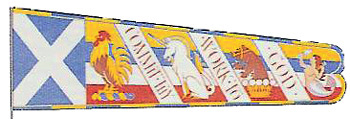
Standard of the Chief of Clan Sinclair
Standard – an elongated shape, tapering from 1.2 m down to 60 cm, with the fly edge split and rounded (lanceolate). The length is according to rank, from 7.5 m for the Sovereign down to 3.5 m for a Knight, Baron or Chief. It bears the Arms as on the shield, with the tail parted per fess with the Crest, Badge and/or Supporter, plus the motto on one or more Ribands. The Standard is set before the Chief’s tent (as it’s a “Headquarters” flag and does not indicate that the Armiger is in residence) rather than carried like the banner. A Standard requires a separate grant by the Lord Lyon and is only made under certain conditions.
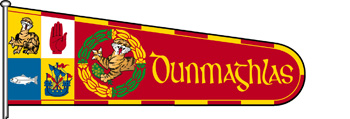
Guidon of MacGillivray of Dunmaglass
Guidon – one-third shorter than a Standard and tapering to a round, unsplit end at the fly. These are assigned by Lord Lyon to individuals who have Supporters to their Arms, and to others who have a following – those in a position of leadership or some official position.
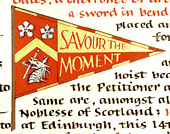
Duncan Pennon
Pennon – a smaller, elongated flag 4 ft long with a pointed, rounded or swallow-tailed end, designed to be displayed on a lance, assigned by Lord Lyon King to an Armiger who applies for one. It is charged with the personal heraldic badge or some other armorial ensign of the owner.
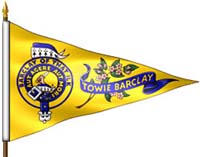
Pincel of Barclay
Pennoncelle or Pincel – a modification of this, 1.3 m long x 60 cm high at the hoist and tapering away to a point, bearing the Crest Badge and perhaps the Motto on the livery colours. This is flown by anyone officially representing or delegated by the Chief, so tents at gatherings and games usually fit the bill. HOWEVER, it is allotted only to Chiefs or particular Chieftain-Barons only upon the specific authority of Lord Lyon.

Parade Banner, Grant
Banner – a square or rectangular upright representation of the Arms designed for carrying in warfare or tournaments, but now flown as a “house flag” when the Armiger is in residence and is NOT the flag of the Clan or Family. Originally, conspicuous gallantry in battle was marked by cutting off the tail of the Standard or Pennon, turning it into a Banner. Strictly speaking, the sizes and shapes are:
Square banner – Sovereign, 1.5 m square; Dukes; 1.25 m sq; Earls, 1.1 m sq; Viscounts and Barons, 1 m sq; Baronets and feudal barons, 0.9 m sq; other Armigers, 70 cm wide x 85 cm high
Rectangular banner – typically in the ratio 3:2, or 5:4 when flown as the “house flag” of an Armiger.
Carrying flag – this should be sized as follows (width x height): Peers, 1.2 m x 1.5 m; Feudal Barons, 90 cm x 115 cm; Chiefs, 85 cm x 110 cm; Chieftains, 80 cm x 90 cm.

The Gonfalon of Durie
Gonfalon – a vertically-hung banner bearing the Coat of Arms, widely used in processions and carried before the Armiger (such as the Chief).
Ensign – small, decorated (often with a gold fringe) of the livery colours, bearing the full Achievement of Arms, usually on a stiff backing. These are seen, for example, on stall-plates.
Table banner – similar to an Ensign, but designed for an Armiger to put on the dinner-table.
Pipe banner – rather similar to a Banner, but of a size to fit on the longest drone of the pipes (usually 45 cm) and richly decorated with gold fringing, tassles and the like. The pipe banner for a Chief who is also a Peer or a Feudal Baron should have a rounded end extending beyond the length, and any other Chief a split rounded end.
SO WHAT CAN WE USE ON OUR TENT OR IN A PROCESSION?
The bottom line is – all these “flags” are meant to represent the Armiger, and must have been granted by Lord Lyon. If your Chief is there, by all means fly his or her Banner or Pennon. If the tent is a temporary “Headquarters” of your Chief, display the Banner. If delegated, fly a Pincel with the authority of (and as a sign of fealty to) your Armigerous Chief.
If there are other Armigers around, why not have a Shield or Ensign made for each, and hang these outside the tent? In procession, carry a Gonfalon before the Armiger concerned.
Otherwise, get a Pincel made showing ONLY the Chief’s Crest Badge.
There is more (official!) guidance at www.lyon-court.com/lordlyon/375.html, but notice that all references to “square metres” should be to “metres square”.
4. Tartan and Highland Wear
Which Tartan?
Essentially, wear what you like, within the limits of good taste and polite behaviour. Tartans are not regulated in the way that Arms are, although there is an official Register of Tartans maintained by the Keeper of Tartans, who is the same person as the Keeper of the Records of Scotland and Registrar-General (www.tartanregister.gov.uk). The Register contains those designs accepted, but of course new tartans are being designed all the time.
Do not confuse this with commercial organisations such as the soi-disant Scottish Tartans Authority – a fine resource in its own right, but not official in any way.
Also, just because some weaving company decides to advertise “The Ancient McSomething” does not necessarily mean it is either “ancient” or anything at all to do with the McSomethings, who may not even know of its existence.
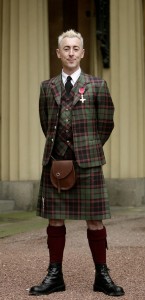
Actor Alan Cumming
Wear the tartan related to your surname, or if there isn’t one, of a relevant district. You may belong to a body which has a tartan (such as a regiment or corporation) and some Clan and Family Associations have designed tartans specifically for their members.
In any case, many so-called “ancient” tartans were picked from existing pattern books around 1822, and most Lowland Families would never have had a tartan anyway.
Ladies’ sash
It may not come up, but if attending a formal event, a lady may wish to wear her surname tartan or that of her husband, as a sash. A previous Lord Lyon wrote the "rules" below, but frankly they have no historical or cultural basis, and the Lord Lyon has no business pronouncing on them anyway. Look at any collection of old portraits of Chiefs' Ladies, female Chiefs and other women of distinction, and notice that their sashes are worn however they pleased. There is one common-sense rule - if you plan to go in for Highland dancing, you may want to keep your right arm free. Otherwise, do feel free to ignore all this:
Crest Badge
Wear the Chief’s badge proudly, as a kilt-pin, cap-badge, fly-plaid clasp or brooch.
5. Weapons
Let’s be very, very clear here – it is ILLEGAL to go about in public in Scotland armed with sharp implements. And let’s not have any nonsense about “our ancient right to bear weapons” or other fictions – your rights are precisely what the law says your rights are, and the law says – DON’T.
There is an exception – a blade of length less than 3.5 inches worn as part of ethnic dress is exempt from the Knife Act [1], but only if kept sheathed. Anything longer – and any knife at all if brandished about – becomes an offensive weapon in the eyes of the law and could get you four years in prison and a fine of £5,000. Most of us choose to wear a fake ceremonial sgian dubh in the sock, just for show.
Indoors, in private, is a different matter, but most clubs, pubs etc. will not allow any weapon on the premises, kilt or no kilt.
The Scottish Police are generally sensible about such things at processions, games and so on, but there is an increasing trend for them to take a zero-tolerance stance and just ask everyone to disarm. Right now. Or else.
Anyone attempting to bring a metallic weapon into the country will find it gets confiscated at airport security.
If you would like to apply for Arms, have your genealogy investigated or need documents transcribed/translated, visit www.brucedurie.co.uk
You may also be interested in the most authoritative guide to such matter – J H Stevenson’s “Heraldry in Scotland”. This two-volume 1915 work is now available in a single-volume hardback edition from www.brucedurie.co.uk/books
[1] The Criminal Law (Consolidation) (Scotland) Act 1995 Sec. 49, Sub-sec. 5(c) and in England and Wales, the Criminal Justice Act 1988 (section 139)[7] and the Offensive Weapons Act 1996 (section 3 and 4).
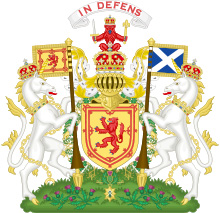
The Full Achievement Arms of King James V of Scotland
As written by Dr. Bruce Durie BSc (Hons) PhD OMLJ FCollT FIGRS FHEA FRSB CBiol QG
found on:
http://www.clans2014.com/clan-heraldry-what-you-can-and-cant-wear-and-display/
Content © Bruce Durie and ScotClans.com